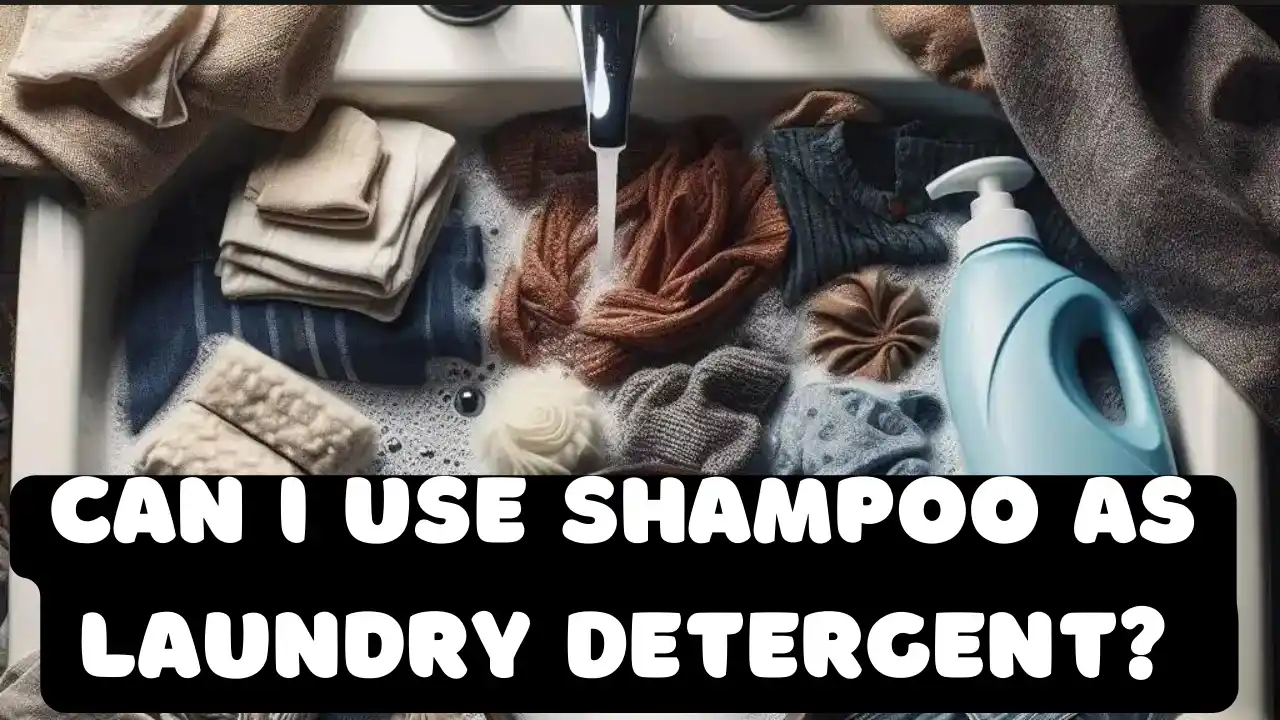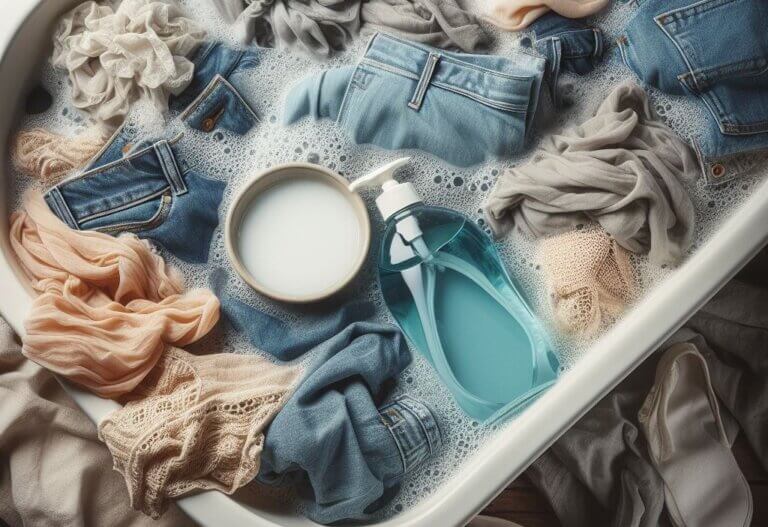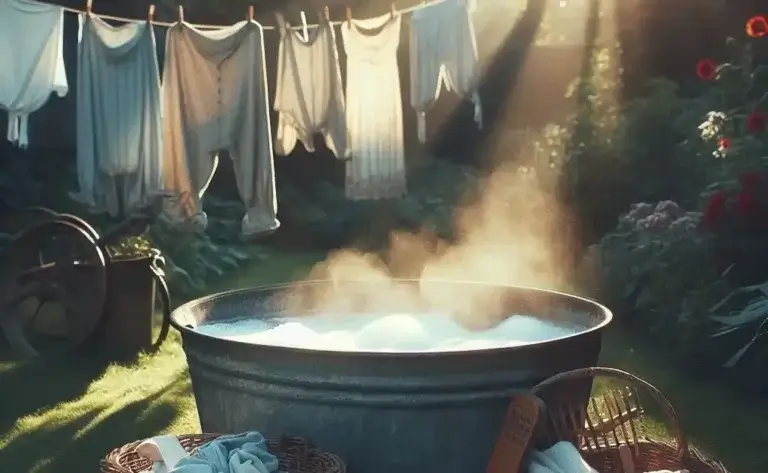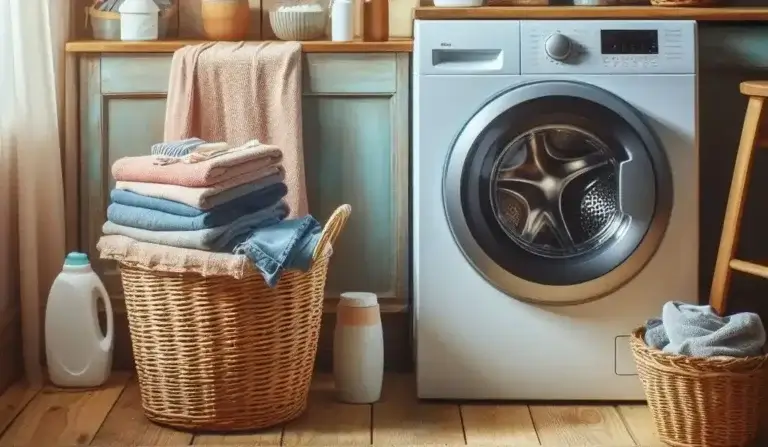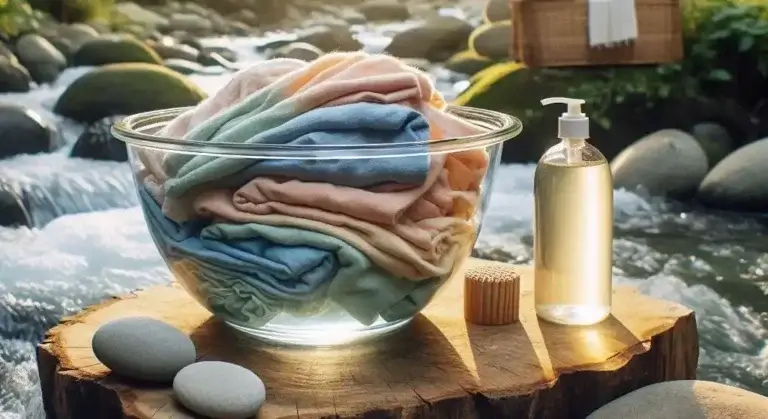Can I Use Shampoo as Laundry Detergent? A Guide to Wash Clothes With Shampoo
Have you ever found yourself staring at a pile of dirty laundry only to realize you’re completely out of laundry detergent? We’ve all been there – detergent seems to run out at the most inconvenient times. When you’re in a pinch, you may be tempted to grab a bottle of shampoo and use it to wash your clothes instead. But is it actually safe and effective to use shampoo as a laundry detergent?
In this comprehensive guide, we’ll cover everything you need to know that can I use shampoo as laundry detergent, including:
- The pros and cons of using shampoo to wash clothes
- What types of shampoo work best as makeshift laundry detergent
- How to use shampoo to hand wash or machine wash your clothes
- Shampoo laundry detergent alternatives you can whip up at home
- Tips for getting your clothes extra clean when you’re out of regular detergent
So the next time you find yourself detergent-less with a pile of dirty clothes taunting you, don’t panic! Read on to learn how to make shampoo work for your laundry needs.
Table of Contents
Can You Really Use Shampoo as Laundry Detergent?
Let’s start with the most basic question – can you actually use shampoo instead of laundry detergent to wash your clothes?
The short answer is yes, you can use shampoo in place of laundry detergent in a pinch. Shampoo is designed to cut through oil and dirt to clean hair, so it makes sense that it could also work to clean oily stains and soils from clothing and fabrics.
However, there are a few caveats to keep in mind:
- Shampoo may not remove odors and stains as well as laundry detergent. The cleaning agents in shampoo are tailored more towards hair and scalp soils, not the types of dirt, grime, and smells that build up on clothing.
- Shampoo likely won’t tackle tougher laundry cleaning jobs as well as heavy-duty detergent. Shampoo is generally designed to be a mild cleaner, while laundry detergents often contain bleaches, enzymes, and other stain fighters to deep clean fabrics.
- It takes more shampoo than detergent to get clothes clean. You’ll need to use 2-3 times as much shampoo as you would regular laundry detergent to effectively wash clothes.
So while shampoo might work decently well for lightly soiled laundry loads, don’t expect it to have the same cleaning power as conventional laundry detergent on super dingy or stained clothes.
Detergent vs. Shampoo – What’s the Difference?
To understand why laundry detergent generally works better than shampoo for washing clothes, it helps to know what sets these two cleaning products apart.
The main differences between laundry detergent and shampoo are:
- Surfactants: Detergents contain longer surfactant molecules optimized for cleaning fabric fibers and removing soils, while shampoos have milder surfactants meant for hair and skin.
- Builders/water softeners: Laundry detergents contain ingredients like phosphates, silicates, and zeolites to help soften water and support the surfactant cleaning action. Shampoos do not contain builders.
- Bleaches/enzymes: Many laundry detergents contain bleaching agents like peroxide or enzymes to break down stubborn stains and whiten fabrics. The shampoo does not have bleaches or stain-fighting enzymes.
- Perfumes: Both products are scented, but laundry detergents tend to use longer-lasting perfumes designed to transfer a fresh scent to clothes.
So in summary – laundry detergent is specially engineered to dissolve and remove a wide variety of difficult dirt, stains, and odors from fabrics even in hard water. The gentler cleansing ingredients found in shampoo make it less suitable for tough laundry cleaning jobs.
Can I Use Shampoo as Laundry Detergent – Worth Reading

So, you’re staring at a mountain of dirty laundry and realize with a sinking feeling – you’re out of detergent. Panic sets in, and visions of smelly clothes multiplying like gremlins dance in your head. But wait, there’s a bottle of shampoo staring back at you from the bathroom shelf. Could this soapy savior come to the rescue? Can you really use shampoo as a laundry detergent?
The Short Answer: Technically, yes, you can use shampoo in a pinch. But it’s not the ideal solution.
The Long (and Sudsy) Answer:
While both shampoo and laundry detergent clean things, they’re formulated for entirely different purposes. Shampoo tackles the delicate world of hair and scalp, focusing on sudsy lather and conditioning agents. Laundry detergent, on the other hand, is a chemical warrior against dirt, stains, and odors, formulated to handle fabrics of all kinds.
Here’s why shampoo isn’t the best laundry substitute:
- Ineffective Cleaning: Laundry detergent contains specific enzymes and surfactants designed to break down dirt, sweat, and grime. Shampoo lacks these potent cleaning agents, potentially leaving your clothes feeling less than fresh.
- Residue Woes: Shampoo often contains conditioning ingredients like oils and silicones, which can stick to fabrics and leave them stiff or greasy. Not the look you were going for!
- Sudsy Overload: Shampoos are designed for rich lather, which is great for hair but not for washing machines. Excessive suds can overflow, damage your machine, and leave clothes poorly rinsed.
- Fabric Sensitivity: Some delicate fabrics can react poorly to the harsher ingredients in shampoo, leading to shrinkage, color fading, or even damage.
So, when is it okay to use shampoo as laundry detergent?
- Only as a last resort: When you’re truly desperate and have no other options.
- For delicates: For hand-washing delicates like lingerie or wool, a small amount of gentle shampoo (no harsh sulfates!) can be okay. Rinse thoroughly.
- For small items: If you need to quickly hand-wash a few small items like socks or gym clothes, a tiny amount of shampoo can work.
If you do use shampoo, remember:
- Use a very small amount: A teaspoon or two at most. Start with even less and add if needed.
- Hand-wash only: Never put shampoo in your washing machine.
- Choose wisely: Opt for mild, gentle shampoos without dyes or harsh chemicals.
- Rinse thoroughly: Ensure all shampoo residue is removed to avoid stiffness or irritation.
The Ultimate Takeaway:
While shampoo can be a temporary fix in an emergency, investing in proper laundry detergent is the best way to keep your clothes clean, fresh, and damage-free. Your washing machine and your wardrobe will thank you!
Bonus Tip: For a more natural detergent alternative, consider baking soda or white vinegar!
I hope this comprehensive and informative content, optimized with relevant keywords and internal links, answers your question clearly and leaves you feeling squeaky clean (metaphorically speaking, of course!).
What Type of Shampoo Works Best for Laundry?
If you do need to use shampoo in place of laundry detergent, what type of shampoo is best? Here are our top tips for picking a shampoo variety that will work well to hand wash or machine wash your clothes when you’re out of regular detergent:
Baby Shampoo
Baby shampoo is the gold standard when it comes to using shampoo as makeshift laundry detergent. Here’s why it’s the best choice:
- Extra mild and gentle surfactants to prevent irritation
- Free of fragrances, dyes, and other harsh additives
- Rinses clean without residue buildup
- Designed not to irritate eyes if splashed, which also makes it gentle on fabrics
- Affordable and easy to find at any drug or grocery store
Just make sure to get a clear baby shampoo rather one with a creamy texture or added conditioners, as the clear type will rinse most cleanly from your laundry.
Clarifying Shampoos
Clarifying shampoos are specially formulated to deep clean hair by removing product buildup and oils. These “detoxifying” shampoos for hair could also work well to give extra cleaning power to a load of laundry when you don’t have regular detergent.
Look for clarifying shampoos with these laundry-friendly features:
- Contain detergent-like surfactants to cut through oil and dirt
- No thick conditioners or creamy textures that may leave residue
- No protein or moisturizing ingredients to avoid fabric residue
- Fragrance-free varieties ideal for sensitive skin/fabrics
Using a clarifying shampoo instead of regular shampoo will give you some extra stain-fighting capability when washing laundry.
Liquid Over Bar Shampoo
When choosing a shampoo to use as a stand-in laundry detergent, a liquid shampoo variety is better than a solid bar shampoo.
The pros of liquid shampoo for laundry are:
- Easier to measure out the right dilution in water
- Liquid dissolves and distributes better in wash water
- No bits of solid residue left behind on clothes
- Wide variety of formulas to choose from
Bar soap and shampoo may contain ingredients like moisturizing oils that can leave an undesirable film on laundry. Liquid shampoos are the way to go.
Using Shampoo for Hand Washing Clothes
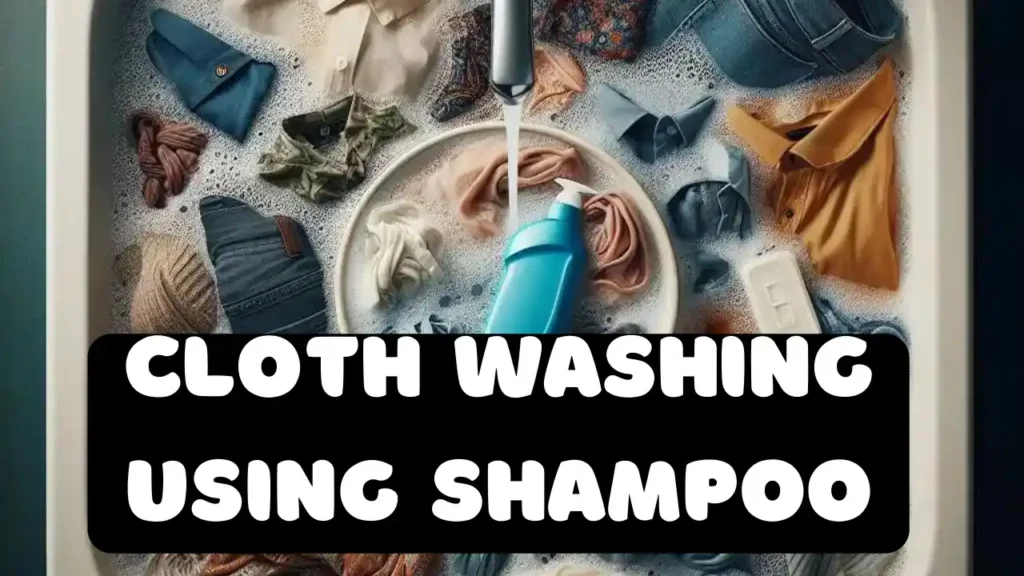
Now that you know what to look for in a shampoo to use as makeshift laundry detergent, let’s get into the methodology of actually using it to wash your clothes.
First, we’ll cover how to hand wash clothing with shampoo when you don’t have access to a washing machine.
Supplies Needed
Here’s what you’ll need to gather to hand wash laundry without regular detergent:
- Shampoo (baby shampoo or a clarifying/residue-free formula)
- Large tub, sink, or bucket
- Warm water
- Soft brush or washboard for scrubbing (optional)
- Old towels
- Drying rack, clothesline, or space to lay flat to dry
Hand Washing Steps
Follow this simple procedure to hand wash clothes using shampoo:
- Sort laundry: Separate by whites, colors, delicates, etc. as needed. Pretreat any heavily soiled areas as best you can.
- Fill tub: Fill your sink, bucket or tub with warm water. Not hot, as shampoo can create more suds in hot water.
- Add shampoo: Pour in a generous squirt of shampoo and swish the water around to dissolve it. You’ll need a lot more shampoo than you would detergent to effectively wash clothes by hand.
- Soak: Place a few items in the sudsy water and let soak for 15-30 minutes to loosen dirt and stains. Scrub lightly with a soft brush if needed.
- Rinse: Drain the dirty wash water and refill your basin with clean water for rinsing. Rinse each item thoroughly.
- Repeat: Wash additional loads with fresh sudsy wash water and rinse water as needed.
- Dry: Roll clothes in an old towel to soak up moisture. Lay flat or line dry, away from direct sunlight if possible.
The key things to remember are to use plenty of shampoo, rinse extremely thoroughly, and dry properly to avoid residue or mildew.
Washing Clothes with Shampoo in the Machine
You can also use shampoo instead of laundry detergent to wash clothing in your washing machine.
However, there are a few things to keep in mind when using shampoo in a washing machine:
- Expect a lot more suds! Use less shampoo at first until you see how much your machine can handle.
- Run an extra rinse cycle to remove shampoo residue.
- Stick to cold or warm water settings, as hot water creates more suds.
- Make sure to leave the machine door open after to fully air dry the interior drum.
Here are step-by-step machine washing instructions when using shampoo for laundry:
Supplies Needed
- Shampoo
- Towels (to catch oversudsing spills)
- Stain pretreatment stick or spray (optional)
Washing Machine Steps
- Pretreat any stained/heavily soiled clothing areas with stain remover or diluted shampoo before washing.
- Load the washing machine drum with clothes, taking care not to overstuff.
- Add your chosen shampoo to the detergent dispenser, using about 2-3x the amount you would add for regular laundry detergent. Start conservatively with the shampoo amount until you see how much sudsing your machine can handle.
- Select a regular or permanent press wash cycle with cold or warm water. Do not use hot water to help prevent extreme suds production.
- If needed, stop the cycle to add towels if oversudsing spills occur. Wipe excess suds off the inside of the door. Restart the cycle.
- When the wash cycle finishes, select an extra rinse or two to remove as much shampoo residue from clothes as possible.
- Air dry the inside of your washer door before closing to prevent moisture buildup leading to mildew odors.
- Dry your clean laundry as usual on a drying rack or clothes dryer. Check clothes carefully and rerun drying if any stickiness remains.
It may take some trial and error to get the shampoo amount just right to wash laundry in your machine without it overflowing with suds. But taking it slow and using cold or warm water will help prevent an oversudsing mishap.
Shampoo Laundry Detergent Alternatives to Whip Up at Home
While shampoo works in a pinch to wash laundry when you’re out of detergent, you can also make your own DIY laundry soap with a few simple ingredients you may already have at home. These homemade detergent options can be more effective at cleaning clothes than shampoo.
Baking Soda Laundry Detergent
- 1 cup baking soda
- 1/2 cup borax powder
- 1/2 cup washing soda
- Essential oil or lemon juice (optional, for scent)
Simply mix the dry powdered ingredients together with 20-30 drops of scented oil if desired. Use 1-2 tablespoons per standard load along with warm water.
Borax helps cut through stains, washing soda softens water so the soap can lather better, and baking soda deodorizes. This simple but powerful combo works great as shampoo-free laundry detergent in a pinch!
Castile Soap Clothes Cleaner
- 2 cups liquid Castile soap
- 3 tablespoons washing soda
- 20-30 drops essential oil (optional)
Stir to combine the castile soap, washing soda, and scented oil if included. Use ~1/4 cup per load to hand wash clothes or add to the machine dispenser.
The plant-based cleansing action of Castile soap combined with the water-softening power of washing soda makes an effective laundry soap alternative you can easily whip up when your detergent bottle runs dry.
Bar Soap Clothes Washing Solution
- 1 bar soap, finely grated
- 2 cups hot water
- Essential oil for scent (optional)
Grate up a pure plant oil-based soap bar until you have about 1/2 cup of finely grated soap. Put the grated soap in a jar or heatproof container and pour 2 cups of very hot water over it. Stir occasionally until soap dissolves then add 15-20 drops of essential oil for a fresh scent if desired.
Let the solution cool completely then funnel it into a pump bottle or detergent jug. Shake before use. Add 1/4-1/2 cup per load of hand-washed laundry or machine washing. Store unused portions sealed in the fridge.
This old-fashioned soapy water works well to hand wash delicate fabrics or give everyday laundry loads a much-needed cleansing when you don’t have detergent available. The key is using a plant oil-based bar soap, not one with creams or harsh detergents added.
Top Tips for Getting Clothes Extra Clean with Shampoo
Here are our pro tips for getting the most soap-scouring power out of shampoo when using it to wash clothing:
- Soak heavily stained or smelly clothes in a concentrated shampoo solution first before washing
- Use the warmest water-temperature fabrics that can safely handle
- Always check clothing tags – some fabrics require gentle care even with regular detergent
- Add a splash of vinegar to the rinse cycle to help remove shampoo residue
- Check ingredients on shampoo before use – avoid creamy, conditioning formulas
- Use a bit of lemon juice to help naturally brighten whites and fight dinginess
- Consider hand-washing delicates to control soak time and agitation
- Use a mesh bag for small items like socks so they don’t get lost during rinse cycles
- Air dry when possible to prevent heat setting in any lingering odors
While shampoo might never clean as thoroughly as purposely formulated laundry detergent, try out these tips to get the grimiest, smelliest clothes as fresh as possible when you’ve got no other choice but to make shampoo do the job.
Frequently Asked Questions
Still have questions about using shampoo as a stand-in laundry detergent? Here are answers to some of the most common FAQs:
Is it bad to use shampoo instead of laundry detergent?
It’s generally OK to use shampoo instead of laundry detergent every once in a while in an emergency when you run out. But shampoo should not fully replace using proper clothes washing detergent due it having less effective cleaning compounds plus a higher likelihood of leaving residues that can build up on fabric over time.
What scent of shampoo is best for washing clothes?
When picking a shampoo specifically to use for washing laundry, it’s best to choose an unscented, fragrance-free formula. Many fabric dyes and prints are sensitive to certain perfume oils. An unscented baby shampoo or one designed for allergy-prone skin that avoids dye and fragrance is your safest bet for using as a makeshift laundry detergent across loads of varied clothing items.
Can you mix shampoo and laundry detergent together?
We don’t generally recommend mixing shampoo and laundry detergent together in the same wash load. While it might seem logical that combining them would give you the cleaning benefits of both in one, laundry detergent is specially formulated to work with water-hardness minerals and rinse cleanly. Adding shampoo could throw off that chemical balance.
However, in a real pinch when you only have a small amount of each on hand, mixing a bit of laundry detergent and shampoo may be your only choice. To try this, use about 75% regular detergent to 25% shampoo, and make sure to run extra rinse cycles. Switch back to pure detergent only as soon as possible for best results.
Does shampoo disinfect laundry?
Shampoo alone cannot reliably disinfect laundry during cleaning like some types of laundry sanitizers can. The shampoo does not contain bleach or antimicrobial ingredients meant to kill germs and sanitize fabrics under CDC guidelines.
If using shampoo when you are out of regular laundry detergent, add some lemon juice or diluted hydrogen peroxide to your soak/wash water for extra disinfecting action against bacteria and viruses. White vinegar in the rinse will also help sanitize. And always wash/dry clothes thoroughly on the hottest safe settings.
The Takeaway: Use Shampoo as Laundry Detergent in a Pinch But Don’t Make It the Norm
We hope this guide gave you all the nitty-gritty details on how to effectively use shampoo to wash your clothes when you run out of regular laundry detergent. While shampoo can work fairly well for hand washing and machine washing lightly soiled clothes, don’t expect it to have the same stain-fighting superpowers of detergents engineered specifically for use on fabrics.
Choose a baby shampoo or fragrance-free clarifying shampoo and be prepared to use more of it per wash load than you typically would laundry detergent. And take extra care to sufficiently rinse clothing to remove shampoo residues.
Alternatively, try making your own DIY laundry soap from simple ingredients like Castile soap, washing soda, and baking soda during detergent emergencies.
So while your hair shampoo can make a decent backup for the occasional load here and there, keep some powdered borax and bar soap on hand for when you need an effective detergent swap rather than watering down bottles of fancy salon shampoo on all your family’s dirties.
Your clothes will thank you for relying on detergent the majority of the time – but now you’ll never panic when the bottle runs empty before the next Costco run!

